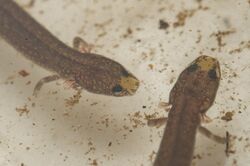Biology:Urspelerpes
| Urspelerpes | |
|---|---|

| |
| Scientific classification | |
| Domain: | Eukaryota |
| Kingdom: | Animalia |
| Phylum: | Chordata |
| Class: | Amphibia |
| Order: | Urodela |
| Family: | Plethodontidae |
| Subfamily: | Hemidactyliinae |
| Genus: | Urspelerpes Camp et al., 2009[2] |
| Species: | U. brucei
|
| Binomial name | |
| Urspelerpes brucei Camp et al., 2009[2]
| |
Urspelerpes is a monotypic genus of salamanders in the family Plethodontidae (the lungless salamanders).[3] It is represented by a single species, the patch-nosed salamander (Urspelerpes brucei), a lungless miniature salamander found in streams of Georgia and South Carolina, United States .[1][4] It marks the first discovery of an endemic amphibian genus from the United States since the Red Hills salamander (Phaeognathus) in 1961.[5]
Description
This genus is believed to be closely related to brook salamanders (genus Eurycea), but have five toes on their feet. A distinctive characteristic is a yellowish patch on the snout. Urspelerpes is tiny, and adults are about 5 cm (2 in) long. Males and females have different coloration, with males having a pair of dark stripes running down their bodies, with yellow backs, and females being more muted in color (a more common trait in birds). Similar to other salamander species, this genus is believed to eat small terrestrial prey using its projectile tongue.[6]
Distribution and habitat
The description of the species, published online in June 2009, for the Journal of Zoology, was based on specimens collected at Stephens County, Georgia, (near Toccoa[7]) in 2007, and several other sites in a region rich in salamander species. U. brucei is endemic to the United States and is its second-smallest salamander.[8]
Etymology
The name Urspelerpes means "archaic" (ur) and "cave creeper" (spelerpes) in Ancient Greek. The specific epithet brucei honors a professor at Western Carolina University, Richard Bruce.[8]
References
- ↑ 1.0 1.1 IUCN SSC Amphibian Specialist Group (2011). "Urspelerpes brucei". IUCN Red List of Threatened Species 2011: e.T185664A8454434. doi:10.2305/IUCN.UK.2011-1.RLTS.T185664A8454434.en. https://www.iucnredlist.org/species/185664/8454434. Retrieved 13 November 2021.
- ↑ 2.0 2.1 Camp, C. D.; Peterman, W. E.; Milanovich, J. R.; Lamb, T.; Maerz, J. C.; Wake, D. B. (2009). "A new genus and species of lungless salamander (family Plethodontidae) from the Appalachian highlands of the south-eastern United States". Journal of Zoology 279: 1–9. doi:10.1111/j.1469-7998.2009.00593.x. http://ib.berkeley.edu/labs/wake/358_JZO_593.pdf.
- ↑ Frost, Darrel R. (2015). "Urspelerpes Camp, Peterman, Milanovich, Lamb, Maerz, and Wake, 2009". Amphibian Species of the World: an Online Reference. Version 6.0. American Museum of Natural History. http://research.amnh.org/vz/herpetology/amphibia/Amphibia/Caudata/Plethodontidae/Hemidactyliinae/Urspelerpes.
- ↑ Frost, Darrel R. (2015). "Urspelerpes brucei Camp, Peterman, Milanovich, Lamb, Maerz, and Wake, 2009". Amphibian Species of the World: an Online Reference. Version 6.0. American Museum of Natural History. http://research.amnh.org/vz/herpetology/amphibia/Amphibia/Caudata/Plethodontidae/Hemidactyliinae/Urspelerpes/Urspelerpes-brucei.
- ↑ Matt Walker (2009-07-08). "BBC - Earth News - Striking salamander species found". BBC News. http://news.bbc.co.uk/earth/hi/earth_news/newsid_8140000/8140003.stm.
- ↑ Matt Walker (July 8, 2009). "Striking salamander species found". Earth News (BBC News Online). http://news.bbc.co.uk/earth/hi/earth_news/newsid_8140000/8140003.stm.
- ↑ "Alumni Magazine: Warnell School of Forestry and Natural Resources". Warnell.uga.edu. 2011-11-11. http://www.warnell.uga.edu/h/alumni/flog/pdf/log_F08.pdf.
- ↑ 8.0 8.1 "Warnell researchers help discover second smallest salamander in U.S.". Warnell News. Daniel B. Warnell School of Forestry and Natural Resources. July 7, 2009. http://www.warnell.uga.edu/news/index.php/2009/07/warnell-researchers-help-discover-smallest-salamander-in-us/.
External links
- Urspelerpes images, Caudata Culture
Wikidata ☰ Q144824 entry
 |


